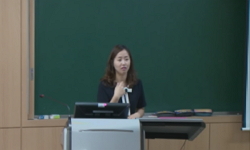The Five Types of Mindfulness(五停心觀) are five kinds of practices as like the contemplation on impurity(不淨觀), the compassionate meditation(慈悲觀), the insight into causality(緣起觀), the contemplation on the elements(界差別觀), ...
http://chineseinput.net/에서 pinyin(병음)방식으로 중국어를 변환할 수 있습니다.
변환된 중국어를 복사하여 사용하시면 됩니다.
- 中文 을 입력하시려면 zhongwen을 입력하시고 space를누르시면됩니다.
- 北京 을 입력하시려면 beijing을 입력하시고 space를 누르시면 됩니다.

오정심관 수행법을 통한 심리치료 = The Mind Healing through the Practices of the Five Types of Mindfulness(五停心觀) in Yogācārabhūmi-Śāstra(瑜伽師地論) Translated into Chinese
한글로보기https://www.riss.kr/link?id=A99939591
- 저자
- 발행기관
- 학술지명
- 권호사항
-
발행연도
2013
-
작성언어
-
-
주제어
오정심관 ; 부정관 ; 자비관 ; 연기관 ; 계차별관 ; 수식관 ; 탐 ; 진 ; 치 ; 만 the Practices of the Five Types of Mindfulness ; the contemplation on impurity ; the compassionate meditation ; the insight into causality ; the contemplation on the elements ; the contemplation on breathe 五停心觀 ; 不淨觀 ; 慈悲觀 ; 緣起觀 ; 界差別觀 ; 數息觀 ; 尋思
-
KDC
220
-
등재정보
KCI등재
-
자료형태
학술저널
-
수록면
298-332(35쪽)
-
KCI 피인용횟수
9
- DOI식별코드
- 제공처
-
0
상세조회 -
0
다운로드
부가정보
다국어 초록 (Multilingual Abstract)
The Five Types of Mindfulness(五停心觀) are five kinds of practices as like the contemplation on impurity(不淨觀), the compassionate meditation(慈悲觀), the insight into causality(緣起觀), the contemplation on the elements(界差別觀), and the contemplation on breathe(數息觀) which are included in the object of perception cognized by means of pure act(淨行所緣) in Yogācārabhūmi-Śāstra(瑜伽師地論).
The contemplation on impurity and breathe was originally recommended by buddha for concentration on body, and these two contemplations were systematized into two main practices that enter to buddhist meditation in Abhidharma buddhism. At last, in Chinese buddhism, these two contemplations were standardized to the Five Types of Mindfulness, including the compassionate meditation, the insight into causality, and the contemplation on the elements.
These Five Types of Mindfulness are named as "the object of perception(所緣)" in Yogācārabhūmi-Śāstra, because each object of the Five Types of Mindfulness is the object of concentration. So each type of Mindfulness is divided to several gates(門) and explained systematically in Yogācārabhūmi-Śāstra. The contemplation on impurity is divided to six kinds of ways as like the decay-dirty-impurity(朽穢不淨), the pain-impurity( 苦惱不淨), the inferiority-impurity(下劣不淨), the seeing- waiting-impurity(觀待不淨), the earthly desire-impurity(煩惱不淨), the rapid decay-impurity(速壞不淨), and explained gradually. Yogācārabhūmi-Śāstra explains that, by these ways, greedy desires(貪慾) to riches, sex, good condition, and body can be removed.
the compassionate meditation is giving kind and good minds as like benevolence(慈), compassion(悲), rejoicing at a person's success and happiness(喜) and so on to whoever he/she is good or not to me without any bad intend or condition to others, By the compassionate meditation, we can remove the mind that be got angry(瞋恚).
The insight into causality is the way to see the beginning, role, and character of the Five Aggregates(五蘊), by which can experience and get the truth of Dharma-nature(法性). We can remove ignorant mind(愚癡).
the contemplation on the elements is the way to see the different marks of four realms in the inside and outside as the constituent of body and nature, and see space-realm(空界) which is space in the body and consciousness-realm in mind. By the contemplation on the elements, we can remove the act fixated on the mind of I and mine.
the contemplation on breathe is described as five kinds of contemplation ways. They are 1)the counting-practice(算數修習) which is counting breathe to remove distracted mind, 2)the Five Aggregates-practice(五蘊修習) by which we can see the truth of dharma, 3) the causality-practice(緣起修習) by which we can see the end of inhalation and exhalation, 4) the holy truth-practice( 聖諦修習) by which we can cut off earthly desire of now and here(現觀) and one cut off when he/she enters into the truth(見道所斷), and 5) the sixteen superiority-practice(十六勝行) by which we can cut off earthly desire disappeared by the practice after he/she enters into the truth(修道所斷).
국문 초록 (Abstract)
오정심관은 부정관, 자비관, 연기관, 계차별관, 수식관의 5종의 수행방법으로써 『유가사지론』은 행위를 깨끗하게 하는 수행대상[淨行所緣]에 포함시킨다. 일반적으로 오정심관 중 부정관...
오정심관은 부정관, 자비관, 연기관, 계차별관, 수식관의 5종의 수행방법으로써 『유가사지론』은 행위를 깨끗하게 하는 수행대상[淨行所緣]에 포함시킨다.
일반적으로 오정심관 중 부정관과 수식관은 붓다가 몸의 제도를 위해 자주 설한 수행법이었지만, 아비달마불교에서는 이 두 수행법을 입문수행의 두 관법으로 체계화시켰던 것들이다. 중국불교에 이르면 두 가지의 수행법에 여타의 자비관, 연기관, 계차별관(또는 염불관)을 포함시켜 오정심관(또는 五門)의 수행법으로 정형화시키게 된다. 『유가사지론』은 이 5종의 수행관법을 수행대상이 된다고 하여 所緣의 이름으로 설정하고, 각각의 수행법에 여러 가지의 門을 세워 체계적으로 접근한다. 다시 말해 부정관은 朽穢不淨, 苦惱不淨, 下劣不淨, 觀待不淨, 煩惱不淨, 速壞不淨의 여섯 가지의 부정관의 방법을 점차적으로 설명하며, 이들 각각의 부정관을 통하여 욕구와 탐욕, 음욕과 음욕에 대한 탐욕, 경계에 대한 욕구와 탐욕, 살가야에 대한 욕구와 탐욕을 제거할 수 있다고 한다. 또한 자비관은 사랑[慈], 연민[悲], 기쁨[喜]의 감정을 사랑하는 사람, 원수 같은 사람, 중간관계의 사람에게 원망심, 적개심, 불해심 없이 조건 없이 주는 것이라고 한다. 결국 자비관을 통하여 다양한 진에의 마음을 제거할 수 있다고 본 것이다. 연기관은 오온의 시작과 작용과 특징을 네 가지로 도리로써 앎으로써 법성의 이치를 증험 또는 체득해 나가는 것이라고 하며, 이를 통하여 우치의 마음을 제거할 수 있다고 한다. 계차별관은 내외의 4계의 차별상을 몸과 자연환경의 구성요소로써 아는 것이라고 하고, 몸속의 공간의 공계와 심의식의 식계를 아는 것이라고 하며, 이를 통하여 아만의 행을 제거할 수 있다고 한다.
마지막 수식관은 입출식에 숫자를 헤아리는 산수수습과 오온수습과 연기수습과 성제수습과 16승행수습의 5종의 관법을 기술하고 있다. 이 각각의 수식관을 닦으면 산란심이 제거되고, 법의 이치를 알고, 입출식의 소멸을 알며, 현관과 견도소단의 번뇌를 끊으며, 수도 소단의 번뇌를 끊어낸다고 한다.
목차 (Table of Contents)
- 국문 요약
- Ⅰ. 들어가는 말
- Ⅱ. 『유가사지론』의 오정심관의 위치
- Ⅲ. 『유가사지론』 오정심관의 방법과 심리치료
- Ⅵ. 나가는 말
- 국문 요약
- Ⅰ. 들어가는 말
- Ⅱ. 『유가사지론』의 오정심관의 위치
- Ⅲ. 『유가사지론』 오정심관의 방법과 심리치료
- Ⅵ. 나가는 말
- 참고문헌
참고문헌 (Reference)
1 小谷信千代, "「五停心觀の成立過程」 釋尊の「法思想」の眞意を求めて" 大谷大學 大谷學會 46 : 1995
2 심준보, "한역본 『염처경』과 『Maha Satipattana Sutta』의 신념처 수행법 고찰 -한역본『염처경』을 중심으로-" 불일출판사 (11) :
3 강명희, "아함에 나타난 부정관과 번뇌의 관계" 보조사상연구원 36 : 295-326, 2011
4 강명희, "아함에 나타난 몸 관찰 수행방법의 순차성" 인도철학회 (35) : 5-27, 2012
5 미산, "대념처경을 중심으로 본 초기불교 수행법" 불교평론사 2003
6 "阿毘達磨俱舍論 제22권"
7 "觀音義疏 제2권"
8 釋惠敏, "聲聞地における所緣の硏究" 山喜房佛書林 1994
9 "瑜伽論記 제6권"
10 "瑜伽師地論 제25권, 제26권, 제27권"
1 小谷信千代, "「五停心觀の成立過程」 釋尊の「法思想」の眞意を求めて" 大谷大學 大谷學會 46 : 1995
2 심준보, "한역본 『염처경』과 『Maha Satipattana Sutta』의 신념처 수행법 고찰 -한역본『염처경』을 중심으로-" 불일출판사 (11) :
3 강명희, "아함에 나타난 부정관과 번뇌의 관계" 보조사상연구원 36 : 295-326, 2011
4 강명희, "아함에 나타난 몸 관찰 수행방법의 순차성" 인도철학회 (35) : 5-27, 2012
5 미산, "대념처경을 중심으로 본 초기불교 수행법" 불교평론사 2003
6 "阿毘達磨俱舍論 제22권"
7 "觀音義疏 제2권"
8 釋惠敏, "聲聞地における所緣の硏究" 山喜房佛書林 1994
9 "瑜伽論記 제6권"
10 "瑜伽師地論 제25권, 제26권, 제27권"
11 안성두, "瑜伽師地論에 있어 '128종 隨眠(anusaya)'說의 성립과 그 특징" 인도철학회 (14) : 2003
12 洪鴻榮, "瑜伽師地論における止觀の構造 遍滿所緣を中心として" 日本印度學佛敎學會 (103) : 2003
13 小谷信千代, "瑜伽師地論と大乘莊嚴經論" 大谷大學 佛敎學會 (32) : 1980
14 "方廣大莊嚴經 제1권"
15 長尾雅人, "所緣行相門の一問題" 東京大學 文學部 宗敎學硏究室內 日本宗敎學會 (87) : 1935
16 "妙法蓮華經玄義 제4권"
17 "大方廣佛華嚴經疏 제24권"
18 "大方廣佛華嚴經 제11권"
19 "增壹阿含經 제6권,제12권"
20 "勝天王般若波羅蜜經 제1권"
21 "仁王護國般若經疏 제2권"
22 "仁王經疏 제3권"
23 김재성, "五停心觀의 초기불교에서의 위치" 불교학연구회 31 (31): 183-224, 2006
24 김호귀, "五停心觀과 達磨의 四行" 천태불교문화연구원 (4) : 2003
25 勝野隆廣, "五停心觀について" 천태학회 (1) : 1988
26 강명희, "『유가사지론』 「성문지」에 나타난 편만소연의 의미와 특징 - 한역본 중심으로 -" 불교문화연구원 (62) : 199-223, 2012
27 淸水海隆, "『瑜伽師知論』における聲聞道と菩薩道" 日本印度學佛敎學會 (90) : 1997
28 이윤옥, "『瑜伽師地論』의 「聲聞地」에서의 轉依 개념" 불교학연구회 21 (21): 57-95, 2008
29 佐久間秀範, "『瑜伽師地論』における轉依思想" 日本印度學佛敎學 (77) : 1990
30 本村耐樹, "『瑜伽師地論』におけるvastuとnimittaの關係 三性說との關係において" 日本印度學佛敎學會 (107) : 2005
31 강명희, "『瑜伽師地論』 「聲聞地」의 構成과 그 修行體系" 한국불교연구원 20 : 2004
32 三穗野英彦, "Śrāvakabhūmiにおける四種所縁の関係について--遍満所縁の位置づけに関する先行研究批判を中心として" 廣島哲學會 53 : 2001
동일학술지(권/호) 다른 논문
-
- 보조사상연구원
- 김방룡(Kim, Bang-Ryong)
- 2013
- KCI등재
-
- 보조사상연구원
- 고영섭(Ko Young Seop)
- 2013
- KCI등재
-
- 보조사상연구원
- 정희경
- 2013
- KCI등재
-
『염불요문(念佛要門)』에 대한 오노겐묘(小野玄妙)의 해석 연구
- 보조사상연구원
- 권동우(Dong-Woo Kwon)
- 2013
- KCI등재
분석정보
인용정보 인용지수 설명보기
학술지 이력
| 연월일 | 이력구분 | 이력상세 | 등재구분 |
|---|---|---|---|
| 2023 | 평가예정 | 재인증평가 신청대상 (재인증) | |
| 2020-01-01 | 평가 | 등재학술지 선정 (재인증) |  |
| 2019-12-01 | 평가 | 등재후보로 하락 (계속평가) |  |
| 2016-01-01 | 평가 | 등재학술지 선정 (계속평가) |  |
| 2015-12-01 | 평가 | 등재후보로 하락 (기타) |  |
| 2011-01-01 | 평가 | 등재학술지 유지 (등재유지) |  |
| 2009-01-01 | 평가 | 등재학술지 유지 (등재유지) |  |
| 2006-01-01 | 평가 | 등재학술지 선정 (등재후보2차) |  |
| 2005-05-31 | 학술지명변경 | 외국어명 : BOJOSASANG, Journal of Bojo Thought -> Journal of Bojo Jinul's Thought |  |
| 2005-01-01 | 평가 | 등재후보 1차 PASS (등재후보1차) |  |
| 2003-01-01 | 평가 | 등재후보학술지 선정 (신규평가) |  |
학술지 인용정보
| 기준연도 | WOS-KCI 통합IF(2년) | KCIF(2년) | KCIF(3년) |
|---|---|---|---|
| 2016 | 0.62 | 0.62 | 0.65 |
| KCIF(4년) | KCIF(5년) | 중심성지수(3년) | 즉시성지수 |
| 0.67 | 0.53 | 1.608 | 0.46 |





 KCI
KCI 스콜라
스콜라






